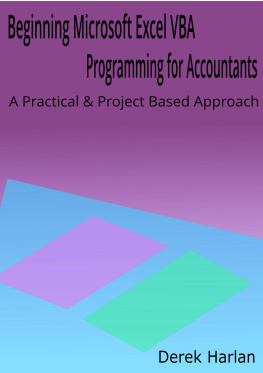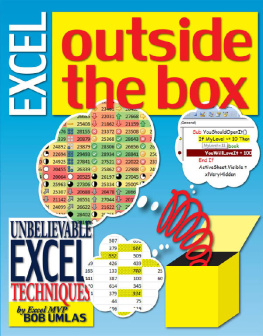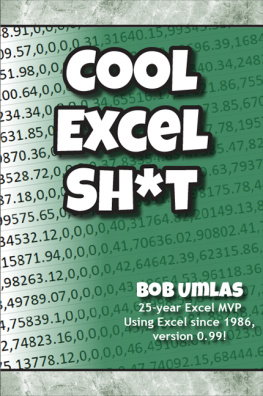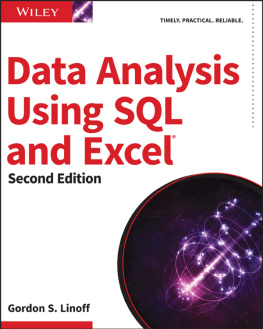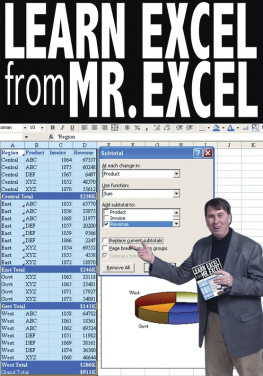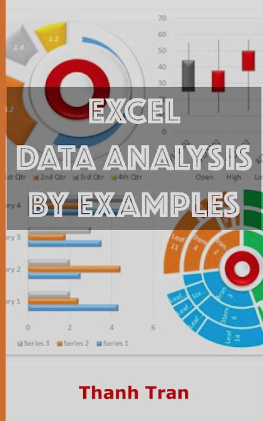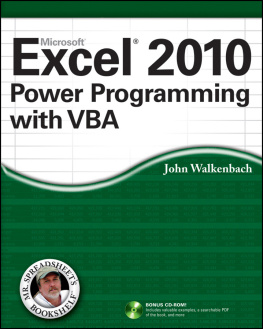Beacham - Pushing Excel - Application Design
Here you can read online Beacham - Pushing Excel - Application Design full text of the book (entire story) in english for free. Download pdf and epub, get meaning, cover and reviews about this ebook. year: 2020, genre: Computer. Description of the work, (preface) as well as reviews are available. Best literature library LitArk.com created for fans of good reading and offers a wide selection of genres:
Romance novel
Science fiction
Adventure
Detective
Science
History
Home and family
Prose
Art
Politics
Computer
Non-fiction
Religion
Business
Children
Humor
Choose a favorite category and find really read worthwhile books. Enjoy immersion in the world of imagination, feel the emotions of the characters or learn something new for yourself, make an fascinating discovery.

Pushing Excel - Application Design: summary, description and annotation
We offer to read an annotation, description, summary or preface (depends on what the author of the book "Pushing Excel - Application Design" wrote himself). If you haven't found the necessary information about the book — write in the comments, we will try to find it.
Beacham: author's other books
Who wrote Pushing Excel - Application Design? Find out the surname, the name of the author of the book and a list of all author's works by series.
Pushing Excel - Application Design — read online for free the complete book (whole text) full work
Below is the text of the book, divided by pages. System saving the place of the last page read, allows you to conveniently read the book "Pushing Excel - Application Design" online for free, without having to search again every time where you left off. Put a bookmark, and you can go to the page where you finished reading at any time.
Font size:
Interval:
Bookmark:

Pushing Excel
Application Design
Pushing Excel VLOOKUP() by Cliff BeachamCopyright Clif Beacham 2019. Al rights reserved.
Printed in the United States of America.
Published by Cliff Beacham Inc.,
4621 E Colorado St, Long Beach, CA 90814.
This book may also be purchased for educational, business, or salespromotional use. Online editions are also available for most titles inthe series.
Editor: Cliff Beacham
Production Editor: Cliff BeachamCopyeditor: Cliff Beacham
Proofreader: Cliff Beacham
Cover Designer: Cliff Beacham
Interior Designer: Cliff BeachamIllustrators: Cliff Beacham
Printing History:
March 2019: First Edition.
Trademarks:
Many of
the
cliffcpa.com
designations used by manufacturers and sel ers to distinguish their products are claimed as
Pushing
Excel
Application Design
by
Cliff Beacham
CPA, MBA, MCDBA
This book examines the topics of Application Design, it discusses and pushes Excels boundaries by adapting it to various scenarios and how to extend the designed use of Excel features.
Published by Amazon Kindle
About the Author
Cliff Beacham has spent many years working with spreadsheets from the days of Visicalc, through Lotus 123 and final y Microsoft Excel.
His career as an accountant started with being at first a Chartered Accountant and then a CPA. In addition he holds an MCDBA (Microsoft Database Administrator) qualification. This indicates his emphasis on data and information. His book entitled SQL A simple introduction by Cliff is selling on Amazon.
However, he is mostly focused on solving accounting problems and uses Excel as his chosen tool.
In this book he shares his experience and knowledge (with many practical examples) it aims to change the way the reader sees Excel
he counters some of the negative views of spreadsheets and discusses the many advantages as Cliff is inclined to say at the end of the book
Is your life now changed?
Cliff claims that if a reader reads and understands this book, their knowledge and ability with Excel wil grow to the level of expert.
Pushing Excel Application DesignTable of Contents
2A. General
2A.1 Excel can be used as:
2A.1a Be Careful What You Wish For!
2A.2 Applications
Facit Calculator (circa 1944)
2A.2a Development goes in cycles
2A.3 UI Design Objectives
2A.4 Change Control
2B. Structural Design Framework
2B.1 Framework
2B.2 Implement process and design methods 20
2B.3 Objectives
2B.4 User needs
2B.5 Key variables standing data
2B.6 Modules & steps (minimize number) 27
2B.7 Example of Design specs
2C Interface - Menus + Other User Interfaces
2C.1 Intuitive
2C.2 Logical
2C.3 Dropdowns List Technique
2C.4 Output Reports
2C.5 Presentation and Format
2C.6 Navigation
2C.6a Aids to Navigation
2D Internal control system
2D.1 Dangerous current trends
2D.2 A 2020 operational paradox
2D.3 Totals
2D.3a Example: Total for a SUMIFS() Summary 47
2D.3b Example in action: Balance should be zero 49
2D.4 Agreement - Source & Destination 50
2D.4a Round-tripping
2D.4b Common key
2D.5 Reviews
2D.5a Review Summary
2D.5b Review Comparison to Expected Results 51
2D.5c Review Trends 51
2D.5d Review Accuracy of Calculations 51
2D.5e Review - Audit Area
2E. Documentation
2E.1 Objectives
2E.1a Example 1 - Objectives
2E.1b Example 2 - Objectives
2E.2 Application Structure (Architecture) diagram 58
2E.2a Example 3 - Structure diagram
2E.2a Example 4 - Structure diagram
2E.3 Explanation
2E.3a Example 5 - Explanations
2E.4 Specific challenges & solution explanations 60
2E.4a Example 6- Specific challenges & solution explanations 60
2E.5 Functions used (explanations in a separate sheet) 61
2E.5a Example 7 - Functions used
2F. Opening Macro
2F.1 Example opening macro code:
2G. Things to Avoid and Rules to fol ow
2G.1 Dos
2G.2 Dont
12H Typical use
12H.1 Sub-ledger
12H.1a M/End analysis
12H.1b Rolling Recons
12H.1c Worksheet = Page Technique
Pushing Excel
2A. General
If you do not have time to do it properly, how are you going to find the time to fix it? Note: I have said this before and will say it again and again!
In general, application design is common sense but there seems to be nothing common about sense! This is not rocket science it has been said 1000x.
If you do not invest the time at the beginning, you will regret it later
and the later you leave it, the more difficult and time-consuming it wil be to fix it. Often I recommend to my clients that we should start over
this time properly they do NOT like to hear that wanting a quick-fix
which is the approach they used in the beginning!
This chapter tackles the topic of design which can be considered a thought process rather than a methodology. It is quite dangerous to restrict our thinking by imposing any rigidity of methodology so please read this chapter in the spirit in which it was written. It is a bunch of things to think about but it is your application your creation and your design.
Creativity is required to develop applications and Excel does a wonderful job of providing some great tools without restricting the developer more than necessary for the type of application that can be developed.
So this is not a recipe to follow but rather a number of suggestions and points for a developer to consider when designing an Excel application.
There is/are
certain common threads and ideas that flow through most applications.
a databank of good practice
a workable approach a solution that has some universal applicability.
Application Design
We wil explore some of these ideas and hopeful y you wil be able to add your own to them to form your own individual style.
Firstly, do not expect a recipe for an application nor a methodology. It is a matter for judgment. The application does the job in the circumstances or it does not. It is easy to use or it is not. It is effective or not, efficient or not and it can be said to be a good application or not. In the end there are some suggestions I wil make and some caveats that I warn against but, in the end, it is up to the developer
who will do it their way.
Many people use a spreadsheet as a clever typewriter. They type the input into the output and mix input values with workings hard coding values in formulas. Then they have the gall to label the result as
Spreadsheet Chaos or Hel , conveniently ignoring the fact that it is of their own making; not Excels.
By now if you have read this far you know that Excel basical y consists of:
a data store (using XML)
a program that updates the data store
an interface
all of which comprises of a number of worksheets in a workbook.
Of course, there can be more than that (Charts, VBE, Add-ins etc but you get the idea).
There are three application tracks to developing: 1. Users the interface
2. Developers the calculations and business logic 3. Storage Data storage has to be optimally designed and managed.
Each of these tracks require careful consideration and none are complete by themselves. The integration of these layers is what makes an application efficient and effective.
Next pageFont size:
Interval:
Bookmark:
Similar books «Pushing Excel - Application Design»
Look at similar books to Pushing Excel - Application Design. We have selected literature similar in name and meaning in the hope of providing readers with more options to find new, interesting, not yet read works.
Discussion, reviews of the book Pushing Excel - Application Design and just readers' own opinions. Leave your comments, write what you think about the work, its meaning or the main characters. Specify what exactly you liked and what you didn't like, and why you think so.

